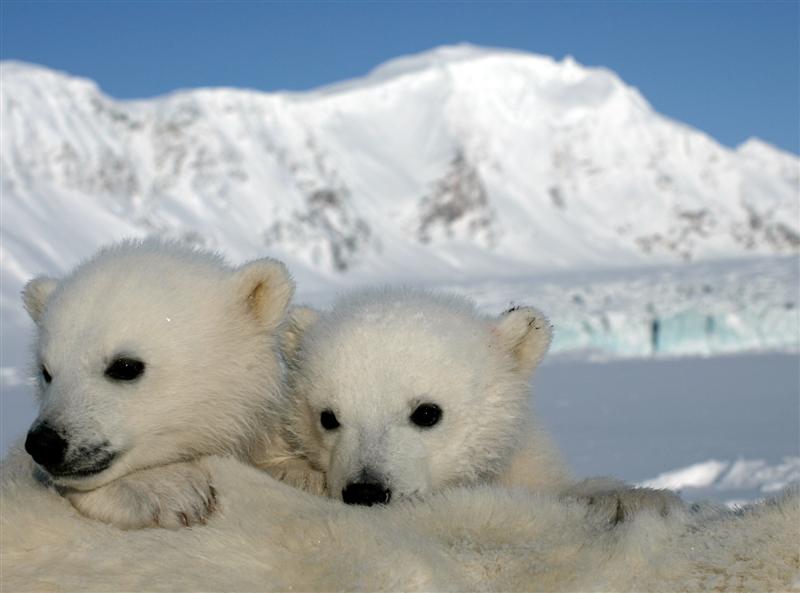
A polar bear in the distance - but it was soon to come a lot closer! Photo by Tom Arnbom
After another beautiful night with the midnight sun, I get a few hours sleep before it is time for breakfast. BUT what a breakfast! While having muesli I see two different polar bears – that is luxury above all means. One of them, is like frozen to the ground, not moving a single bit, just beside a breathing hole for a seal. The white bear is hunting ringed seals. I see the seal coming up in an alternative breathing hole 15 metres from the large predator. But the polar does not move. After 15 minutes, the bear gives up and linger off. Not bad for breakfast time.

Hannibal goes in for an icy plunge. Photo by Tom Arnbom
It is getting colder, and the long johns are on all the time. A cold northerly cuts through all our clothing. We are heading south to get away from the bad weather which is forecasted. Hannibal does not care about the chill, and makes a dive north of the 80th latitude.
DAY 5 – LATE NIGHT
Close to Hinlopen, we force the bow into the sea ice and stay put. At a small distance away, a polar bear is lying on its back with all four paws in the air and scratching its back. It seems not to care less about us.
Suddenly, the bear changes its behaviour. It stands up, sniffs and looks at the boat Explorer of Sweden. Slowly it walks in a zig-zag track towards us. It comes closer and closer – a hundred metres turns into fifty metres, twenty metres. We are all on alert and barely breathing – only whispers. Both Ola and Per-Magnus bring out their weapons and other protective gear – such as sound blasters, both are ready just in case …
The polar bear gets more and more curious and it makes its way all the way to our sailing vessel. It is a bit nervy and the adrenalin is flowing. When it puts the paws on the bow it was close to the limit where we felt safe – the polar bear is incredibly fast and strong so you need margins!
The bear went away from the boat but came back again, this time with higher speed. Ola honked the boat horn – the sound blast is very loud – but the bear barely flinched. So Per-Magnus threw a sound blaster in font of the bear – the high bang surprised the bear – which stops within a metre.

The bear comes close to the boat. Photo by Tom Arnbom
In less than a second the bear runs off away from these ”unfriendly” humans who do not want to get a close contact. The bear stopped after a hundred metres and turned around, gave us a long look and then slowly wandered off to the glacier at the horizon. An encounter to remember – both for us and the bear.

The bear sniffs the air and comes even closer! Photo by Tom Arnbom
The wind picked up, blowing half storm and the seawater temperature is now below zero degrees. Freezing.
DAY 6
After the close encounter with the polar bear we steam south. The wind is now really strong, storm and the water temperature is now the unbelievable minus 1.4 degrees. Not my cup of tea for a swim. It is very very cold and we do not go outside voluntarily.
We sail by an endless glacier front. The colour is ice blue. I just read that during the last five years the Arctic sea ice has lost around 15 cm per year in thickness, that is unbelievably fast. It is going much quicker than anybody has foreseen. This means that the annual ice is dominating the Arctic, and the sea ice can therefore melt off very quickly if the ”right” conditions come. When the white sea ice melts away the sea is opening up and the dark blue water will be warmed up by the sun. The sea will in its turn melt off more sea ice, a process which might not be halted. But we can halt the climate changes if we want.
A first step is a very good climate agreement in Copenhagen in December this year.

Viewing the 'endless glacier' from the boat. Photo by Tom Arnbom





















